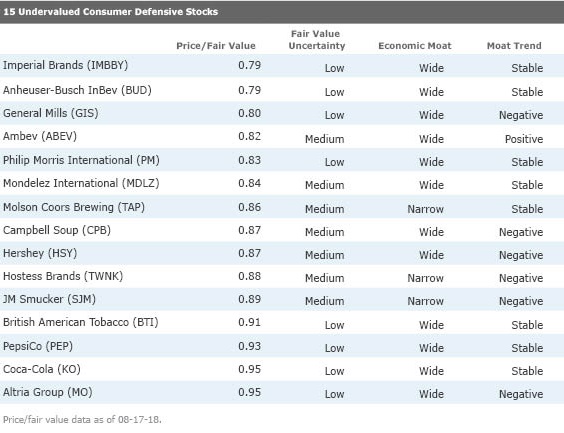15 Stocks for Tailgating Season
These high-quality consumer defensive stocks are trading below our fair value estimates.
Before we dive in, please forgive me: This list is not as whimsically compiled as it might seem. I screened our global equity research to target high-quality stocks (as measured by moat) with stable cash flows (medium or low fair value uncertainty), trading at a meaningful discount to our fair value estimate.
The screen yielded a list that was dominated by consumer defensive stocks, many of them tobacco producers, alcoholic beverage-makers, and snack food and soft drink companies. These types of firms tend to be characterized by stable earnings, and many of them pay healthy dividends. They can add some stability to a portfolio as they tend to hold up relatively well during downturns while also participating in rising markets. For example, in 2008, there weren't too many places to hide; the broader Morningstar Global Markets Index lost a savage 42%, while the Morningstar Global Consumer Defensive index lost 24%--still bad but not as brutal. The sector tends to lag in strong equity rallies: Over all short-term periods the Global Consumer Defensive Index lags the Global Markets Index. But over 10-, 15-, and 20-year periods, it has gotten ahead of the broader index by losing less in tough markets.
It's also late August, and tailgating season is upon us.
Some of the firms, such as the alcohol producers and tobacco companies, may not appeal to investors for moral or ethical reasons. Others may find some ideas worthy of further investigation. We provide a more in-depth look at four of the undervalued stocks on our list.

AB InBev's second-quarter report contained mixed news on the underlying performance of the business. Equity analyst Phil Gorham believes that many of the issues the market may be concerned about will blow over. AB InBev has a wide economic moat that should help it to sustain its competitiveness in most markets in the long term, and with material upside to our fair value estimate, we think the weakness presents a buying opportunity, Gorham said.
He believes AB InBev's wide economic moat stems from two sources: a material cost advantage over its peers and intangible assets. The strongest source of AB InBev's moat, in our opinion, is its cost advantage. The firm holds a dominant market share of close to 70% in Brazil, the third-largest beer market in the world by volume, and controls around half of the U.S. market, the world's second largest. This concentration of scale in its key markets reduces manufacturing complexity, leverages the firm's high fixed-cost base, and lowers the average cost of production, which is apparent in AB InBev's best-in-class profitability, Gorham said.
Gorham recently lowered his fair value estimates for some global large-cap tobacco manufacturers, including Imperial Brands and Philip Morris International, after taking a less optimistic view of medium-term margins. Nevertheless, he still believes these two stocks have upside.
Strong intangible assets at the premium end of its portfolio are at the core of Imperial Brands' wide economic moat, Gorham said. In addition, the company's broad platform of nicotine and tobacco products, which is being extended to include next-generation products, particularly in vaping, gives the firm economies of scope and scale that make it difficult for new entrants to overcome. PMI's economic moat, meanwhile, stems from its core combustible business are strong brand equity and a cost advantage from scale efficiencies.
In both companies' cases, the addictive nature of tobacco products makes demand fairly price inelastic, and a favorable industry structure exists for the largest players in which pricing, for the most part, is rational, Gorham said.
As a leading player in the global snack category, Mondelez has earned a wide economic moat resulting from the economies of scale derived from its expansive global network--with approximately 80% of revenue derived outside North America--and its portfolio of well-known brands, including Oreo, Nabisco, Trident, and Cadbury.
After acquiring Cadbury in 2010, the firm leveled the playing field with Mars/Wrigley in the higher growth, higher margin global confectionery industry, possessing around 15% global share of the chocolate space, said Erin Lash, director of consumer equity research. Mondelez also holds the top spot in the biscuit aisle (with 18% share of the worldwide space, or more than 4 times the 4% share held by Kellogg and 3% share that Campbell Soup maintains) and the global candy category (with 7% share primarily as Halls is the leading worldwide candy brand). Lash thinks this brand mix makes the firm a valued partner for retailers that depend on leading brands to drive store traffic.

/s3.amazonaws.com/arc-authors/morningstar/3a6abec7-a233-42a7-bcb0-b2efd54d751d.jpg)
/cloudfront-us-east-1.images.arcpublishing.com/morningstar/ZZNBDLNQHFDQ7GTK5NKTVHJYWA.jpg)
/cloudfront-us-east-1.images.arcpublishing.com/morningstar/HE2XT5SV5ZBU5MOM6PPYWRIGP4.png)
/cloudfront-us-east-1.images.arcpublishing.com/morningstar/AET2BGC3RFCFRD4YOXDBBVVYS4.jpg)
:quality(80)/s3.amazonaws.com/arc-authors/morningstar/3a6abec7-a233-42a7-bcb0-b2efd54d751d.jpg)